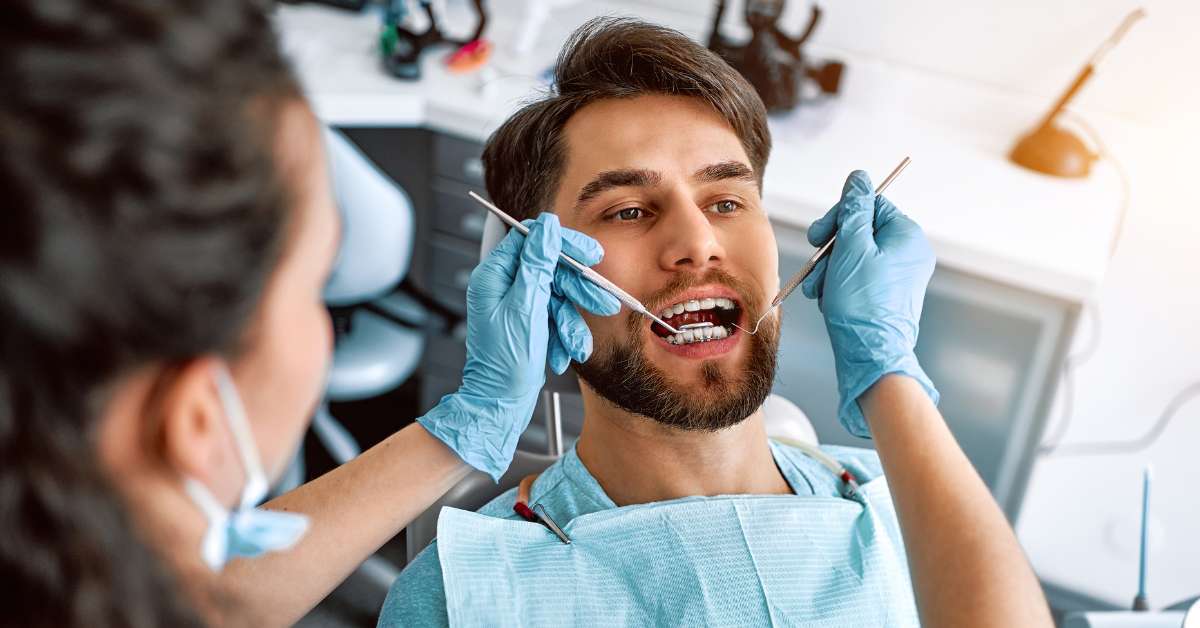Stained teeth treatment is probably something you’ve searched for after catching your reflection and wondering when your smile stopped looking like it used to.
Maybe it’s yellowing that won’t brush off. Maybe it’s a dark spot that wasn’t there before. Either way, it’s frustrating, especially when you’ve tried whitening toothpastes, strips, and mouthwashes with little to no change.
The truth is, stained teeth are common, and they don’t mean you’ve done anything wrong. But if you’re in Jacksonville and ready for a real solution, this guide breaks down what the stains mean, what works, and when it’s time to see a professional.
KEY POINTS
- Not all stains are the same. Surface stains may fade with toothpaste or strips, but deeper stains need professional treatment.
- Dentist treatments work best. Options like whitening trays, bonding, or veneers offer safer, more lasting results.
- Some stains are warning signs. Discoloration with pain or sudden changes could mean decay or damage. You have to get it checked.
Why Teeth Get Stained (and What It Means)
Most stains don’t show up overnight. Apparently, they build slowly. You might notice yellowing, dark spots, or a dull look that wasn’t there before. According to the National Library of Medicine, here’s what’s really behind it, and what the stain type can tell you:
1. Surface Stains (Extrinsic)
These sit on the outer enamel and come from everyday things like:
- Coffee, tea, red wine
- Tobacco use
- Dark sauces and sodas
- Poor brushing or flossing
2. Deeper Stains (Intrinsic)
These develop inside the tooth and are harder to treat with over-the-counter products. Causes include:
- Tooth injuries
- Certain medications (like tetracycline)
- Too much fluoride during childhood
3. Age-Related Stains
As you get older, enamel wears down and reveals more of the yellow dentin underneath. Years of dark foods or drinks don’t help.
Treatment Options Your Dentist May Recommend
If store-bought whitening products haven’t made a difference, you’re likely dealing with stains that go deeper than the surface. That’s when it’s worth turning to professional care. Here are the teeth whitening treatments most dentists recommend, based on the type and severity of staining:
In-Office Whitening
This is the fastest way to see real results. A high-strength whitening gel is applied and activated in the office, often in under an hour. It’s ideal for surface stains and mild yellowing, and many patients leave with a noticeably brighter smile after just one visit.
Custom Whitening Trays
Your dentist creates trays fitted to your teeth, along with a prescription-strength gel to use at home. You’ll wear them daily for a week or two. It’s slower than in-office treatment, but great for uniform stains and anyone who wants to whiten gradually.
Bonding
For isolated stains or deep discoloration that doesn’t respond to whitening, bonding may be the better fit. A tooth-colored resin is applied and shaped over the stained area, blending in naturally. It’s a quick fix that can make a big difference.
Veneers
If your discoloration is widespread or resistant to other treatments, veneers may be the most effective option. These thin porcelain covers are bonded to the front of your teeth, instantly creating a whiter, more even smile.
Crowns
When a tooth has darkened due to injury, decay, or a root canal, a crown can restore both its strength and appearance. Crowns fully cover the tooth and offer long-term protection along with cosmetic improvement.
How to Tell If It’s a Deeper Problem
Some stains are just on the surface. Others go deeper and no amount of whitening will fix them. So, how to tell when tooth discoloration might be a sign of something more serious?
- One Tooth Looks Darker Than the Rest. This could mean past trauma or a dying nerve inside the tooth.
- The Stain Isn’t Fading at All. If you’ve tried strips, trays, or toothpaste and nothing changes, you could be dealing with an internal stain, early decay, or enamel loss.
- You Feel Pain, Sensitivity, or a Bad Taste. If there’s discomfort along with the stain, don’t wait it out. It could be infection or active decay — and the longer you wait, the harder (and costlier) it may be to treat.
- The Spot Gets Bigger or Changes Color. If a small mark keeps growing or darkening, it’s worth getting checked. It might be early-stage decay, and catching it now can save you from needing more serious work later.
How to Prevent New Stains From Coming Back?
Once you’ve whitened your teeth or treated a stain, the next step is keeping your results. That doesn’t mean giving up coffee or red wine forever. It just means you have to be more aware of what affects your teeth.
- Rinse or brush after stain-causing foods and drinks.
- Use a straw for cold drinks
- Brush and floss daily
- Try a whitening toothpaste or rinse
- Quit smoking or using tobacco
- Keep up with your dental visits
Feel Good About Your Smile Again
Stained teeth are common, and they don’t mean you’ve done anything wrong. But if you’re not happy with how your smile looks, you don’t have to settle. With the right treatment and the right dental team, stains can be treated safely, effectively, and often more easily than you think.
At Digital Aesthetic Dentistry, we help patients across Jacksonville restore their confidence with trusted, personalized treatment options.
Book online to schedule your consultation today. Let’s get your smile back on track.
FAQs
Does whitening toothpaste work?
It helps with surface stains, especially if you drink coffee or tea. Look for one with hydrogen peroxide and just don’t expect dramatic results from toothpaste alone.
Are whitening strips a good option?
They can lighten mild stains but often cause sensitivity. Follow directions carefully. Overusing it can irritate your gums.
Do pens or gels make a difference?
Pens are okay for touch-ups. Gels work better with trays, but store-bought ones may not fit well and can cause uneven results or gum irritation.




